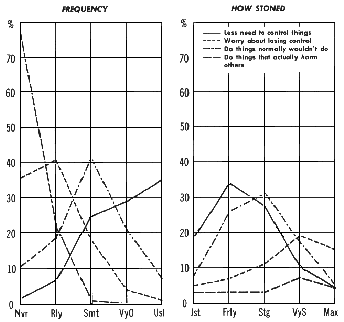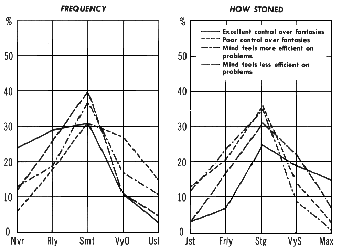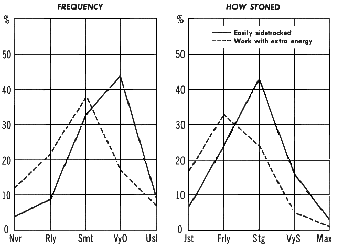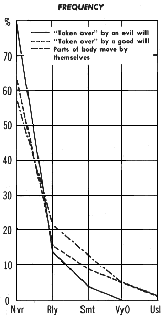
Note.—For guide to interpreting the "How Stoned" graph,
see note on Figure 6-1.

 |
| Figure 17-1. Control Note.—For guide to interpreting the "How Stoned" graph, see note on Figure 6-1. |
 |
| Figure 17-2. CONTROL OVER FANTASIES AND THOUGHTS Note.—For guide to interpreting the "How Stoned" graph, see note on Figure 6-1. |
 |
| Figure 17-3. CONTROL OVER EXTERNAL TASKS Note.—For guide to interpreting the "How Stoned" graph, see note on Figure 6-1. |
 |
| Figure 17-4. "POSSESSION" PHENOMENA |
| TYPE OF TECHNIQUE | NUMBER OF TIMES MENTIONED |
|---|---|
| Focusing, concentrating on current activity | 9 |
| Contact with intoxicated companions | 7 |
| Meditation | 7 |
| Direct willing to get higher | 7 |
| Breathing techniques | 6 |
| Music | 4 |
| Letting go, non-striving, relaxation | 4 |
| Fantasy | 4 |
| Inducing positive emotions | 4 |
| Hypnosis | 2 |
| Miscellaneous | 15 |
 |
| Figure 17-5. ABILITY TO "COME DOWN" AT WILL Note.—For guide to interpreting the "How Stoned" graph, see note on Figure 6-1. |
| TYPE OF TECHNIQUE | NUMBER OF TIMES MENTIONED |
|---|---|
| Direct willing, concentration | 13 |
| Inducing negative emotions | 9 |
| Intense focus on current situation | 8 |
| Acting normal, straight, putting on everyday role | 5 |
| Fantasy, suggestion | 2 |
| Drugs | 2 |
| Miscellaneous | 13 |
| Just | Fairly | Strongly | Very Strongly | Maximum | |||||
| |||||||||
| NO LONGER CAN COME DOWN AT WILL | |||||||||
| Possessed by evil force | |||||||||
| HIGHEST LEVEL, CAN COME DOWN AT WILL | |||||||||
| Body parts move by themselves | |||||||||
| Possessed by good force | |||||||||
| LOSE CONTROL OVER THOUGHTS | |||||||||
| Worry about losing control | |||||||||
| Harm other people | |||||||||
| POOR CONTROL OVER FANTASIES | |||||||||
| MIND FEELS LESS EFFICIENT IN PROBLEM SOLVING | |||||||||
| EASILY SIDETRACKED ON TASKS | |||||||||
| PAIN EASY TO TOLERATE IF ATTENTION DIRECTED ELSEWHERE | |||||||||
| EMOTINS FELT MORE STRONGLY | |||||||||
| EXCELLENT CONTROL OVER FANTASIES | |||||||||
| STRONGLY INFLUENCED BY COMPANIONS | |||||||||
| INHIBITIONS LOWERED | |||||||||
| COMPULSIVE DESIRE TO GET HIGHER | |||||||||
| EMOTIONS FELT MORE WEAKLY | |||||||||
| MIND FEELS MORE EFFICIENT IN PROBLEM SOLVING ? * | |||||||||
| PRE-INTOXICATION MOOD AMPLIFIED | |||||||||
| LESS NEED TO FEEL IN CONTROL OF THINGS | |||||||||
| EXTRA ENERGY, EFFICIENCY, ABSORPTION IN TASKS ? * | |||||||||
| Just | Fairly | Strongly | Very Strongly | Maximum | |||||
| BACKGROUND FACTORS | EFFECTS | |
|---|---|---|
| More Drug Experience | More frequent: Easily sidetracked Extra efficiency, energy for tasks Can come down at will Compulsive desire to get higher More intoxicated for: Easily sidetracked Extra efficiency, energy for tasks Can come down at will | Less frequent: Worry about losing control Can't come down at will |
| Older | More intoxicated for: Compulsive desire to get higher | Less frequent: Poor fantasy control Easily sidetracked Compulsive desire to get higher Less intoxicated for: Inhibitions lowered |
| More Educated | More frequent: Can come down at will | Less frequent: Poor fantasy control Good fantasy control Easily sidetracked Compulsive desire to get higher Less intoxicated for: Easily sidetracked |
| Males | More frequent: Can come down at will | Less frequent: Body parts move by themselves Can't come down at will Less intoxicated for: Can come down at will |
| Therapy & Growth | More frequent: Possessed by good force or will | |